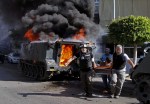On Sunday, NSA leaker Edward Snowden landed in Moscow on a flight from Hong Kong. The United States had asked for Snowden’s extradition, but officials in Hong Kong said the request did not comply with their laws. Snowden will probably not be allowed to stay in Russia, and reports vary on where the fugitive will go next – Cuba, Venezuela, Ecuador, or some other questionable country.
Videos by Rare
The flight from Hong Kong took Washington by surprise, and it is unclear when Snowden will make the next leg of his journey into permanent exile. But the Obama administration might take a lesson from Ronald Reagan. The Gipper’s solution to apprehending airborne fugitives was to go up and get them.
On October 10, 1985, four Palestinian terrorists boarded an EgyptAir 737 charter flight for Tunis. Three days earlier they had hijacked the Italian cruise ship Achille Lauro, holding the passengers and crew hostage and murdering wheelchair-bound 69-year old American tourist Leon Klinghoffer. After the ship docked at Port Said, the Egyptian government secretly agreed to let the hijackers fly to PLO headquarters in Tunis to “face judgment” (and no doubt praise) from Yassir Arafat.
The Egyptians kept mum on where EgyptAir flight 2843 was headed, but U.S. and Israeli intelligence quickly found out. President Reagan was on Air Force One heading for Chicago when he got word. Reagan was determined to bring the hijackers to justice; the Pentagon had been readying SEAL Team 6 to board the Achille Lauro but had to call off the raid when the hijackers fled into Egypt’s territorial waters. Now the Gipper had another chance. He ordered Carrier Air Wing 17, based on the aircraft carrier U.S.S. Saratoga, to intercept the 737 and escort it to the NATO Naval Air Station at Sigonella, Italy.
Rapid, skillful diplomacy was critical to the plan. Mr. Reagan did not want the charter plane actually to be shot down, so the White House sought to limit the Egyptian pilot’s options. The National Security Council and State Department quickly sent cables to Athens and Beirut asking them to deny flight 2843 landing rights. Most importantly, Reagan sent a personal cable to Tunisia’s President Habib Bourguiba saying “the United States had reason to believe … that the hijackers were on board an EgyptAir plane headed for Tunis … [and] believed the terrorists should not be allowed to land.”
Meanwhile F-14 Tomcats had scrambled and were closely following the 737. “We were close enough to look in the windows,” Commander Larry “Vert” Neal, U.S.N. (ret.) told Rare. Vert was flying one of the four F-14’s tracking the 737 through the darkness, with their running lights out. A short time earlier he had been aboard the Saratoga with no notion he was about to fly a mission. The call to launch came “out of the blue” and Vert was airborne in 20 minutes. The only briefing he got was when he was in the cockpit and an officer told him, “Vert, you’re looking for a civilian airliner. You may be cleared to fire.”
As the Tomcats flew alongside the 737, other Navy aircraft picked up the airliner’s radio traffic. They heard Tunis deny permission to land, followed by Athens. The Egyptian pilot asked Cairo for instructions and was ordered back home. At that point the Egyptian pilot was informed he was surrounded by U.S. warplanes and told to proceed to Sigonella. The pilot balked, saying there were no such aircraft. Then the Tomcats switched on their lights. “That really got his attention,” Vert said.
The planes flew to Sigonella where the 737 landed and was surrounded. After a brief confrontation U.S and Italian troops the hijackers were taken into Italian custody for trial. The F-14s returned to the Saratoga. “We still didn’t know what we had done,” Vert said. “We did it all off the cuff.” But he said the mission was an outstanding example of the power of naval aviation to “make things happen.”
Making something happen in the Snowden case would be more complex. The diplomatic situation is tougher. If states like Cuba or Venezuela are willing to give Snowden sanctuary they will not cooperate in his capture. Also while the Achille Lauro hijackers received no sympathy in most of the world, Snowden has quickly built the reputation as a dissident hero for exposing the extent of domestic spying in the United States. Snowden’s flight path is less predictable over such potentially long distances. The assets to intercept him may not be in place (though given this much warning they should be). And a Russian pilot faced with American fighters might be more willing to call Washington’s bluff. However, “intimidation is intimidation,” Vert said. “Commercial airline pilots aren’t used to seeing fighters close up next to them.”
In the end it comes down to leadership, making the decision to act and following through. There are hundreds of excuses for doing nothing. The factor most working in Snowden’s favor today is, no Ronald Reagan.
James S. Robbins is Deputy Editor of Rare and author of Native Americans: Patriotism, Exceptionalism, and the New American Identity. Follow him on Twitter @James_Robbins




2 Comments
Leave a Reply2 Pings & Trackbacks
Pingback:Obama, unlike Reagan, lacks the guts to scramble jets | Rare
Pingback:Putin bitch-slaps Obama over Snowden | Rare